To understand the 1976 2 Dollar Bill value, we must go back to the beginning. Back to 1862, just a year after the U.S. Treasury began printing paper currency.
Through several twists and turns in U.S. monetary policy and financial history, the 1976 2 dollar bill value was reintroduced from a U.S. Treasury Department note to a Federal Reserve Note.
What is the Value of My 1976 2 Dollar Bill?
The eldest millennials may remember coming across a $2 bill once or twice. However, today they are much rarer, and we often wonder about their value.
Some may be worth no more than face value, but a few may be worth thousands, and can make for a great collectible.

The $2 bill changed several times since its first introduction in 1862. The 2 dollar bill remains in circulation today but mostly as a collector’s item.
Knowing what to look for on a 2 dollar bill is the first step toward finding potential value. Is the 1976 $2 bill worth anything? Yes, U.S. paper currency has immense value, including the $2 bill.
But first, let’s understand where the bill originated.

Little Known Facts About 1976 2 Dollar Bill Value –
- The 2 dollar bill was released to banks for distribution on April 13th, 1976 on Thomas Jefferson’s birthday.
- Although the public thought the bill was released specifically for the Bicentennial Anniversary of the U.S., this was not the case. But since the dates coincided, Treasury officials decided to replace the Monticello design on the reverse in place of John Trumbull’s famous painting, ‘Declaration of Independence.’
- Anyone who was issued a 1976 $2 bill on the very first day of issue could have the bill stamped at the post office with the date “APR 13 1976.” Stamped two-dollar bills are available on eBay for only $10 to $15.
- More than 590 million two-dollar bills were printed from the 1976 series by the Bureau of Engraving and Printing. The last bills rolled off the printing press in 1978.
- 1976 2 dollar bills did not circulate well with the general public. The “Declaration” painting on the reverse made many think it was a special commemorative edition bill, which was not the case.
- Do you want a tip for spotting a rare and valuable 1976 series 2 dollar bill? First, check the condition. The bill must be crisp and un-damaged. Next, examine the serial numbers and look for rare combinations that make the bill unique.
1976 Two Dollar Value and History
The two-dollar bill was first circulated in 1862 as a legal tender note despite being recognized as the $2 bill. Along with ones, the two began rolling off the printing presses at the request of Treasury Secretary Salmon Chase.
One year later, fives, tens, twenty-fives, and fifty-cent currency notes began production.
That March, many would see Alexander Hamilton’s profile from the side. Though Hamilton didn’t remain on that specific United States Note, he was later featured on the $10 bill.
The $2 bill was created just one year after The U.S. Treasury Department started printing currency.
Since its introduction, the bill played a part in financial and American history while undergoing several redesigns. Then, a little more than a century later, it became almost nonexistent.
The First Revision of the $2 Bill in 1869
It only took seven years to change the portrait on the two-dollar bill. A picture of Thomas Jefferson replaced the image of Alexander Hamilton.
It is notable that the portrait of Thomas Jefferson remained the face of the $2 bill for the remainder of its life through the present day. On the other side of the bill, we see the picturesque United States Capitol.
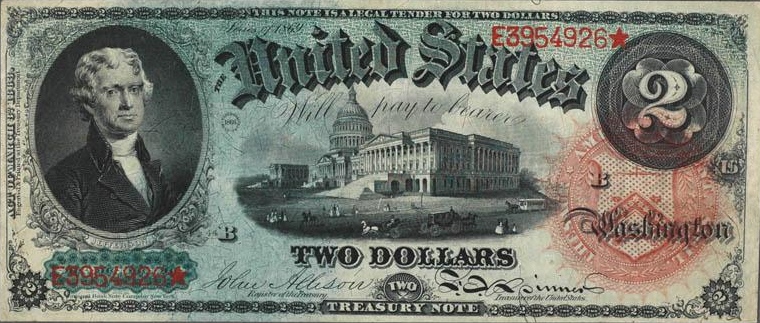
The bill has green tinting on the upper-left corner and features the words Treasury Note signifying some of the unique characteristics of this dollar bill.
It’s worth noting, according to the film “The $2 Bill Documentary,” most people were making less than $15 a month before the 1900s. Most products, goods, and services didn’t cost more than a dollar.
What did this mean?
The $2 bill was strange because the American public initially didn’t know what to use the paper currency for.
Many didn’t see the practical use for a 2 dollar bill because most things cost less than $1. It was rumored that politicians were using $2 bill bank notes for bribery to buy votes.
$2 Redesign in 1874
It didn’t take long for the next redesign. In 1874, there were a few changes to the two dollar note. A red floral design was added.
The Red floral print went around the words Washington D.C. The U.S. Treasury Note also reverted to the “United States Note.”
This design would be reissued in 1875 and 1878.
$2 Note Design Changes Made in the 1880s
The red floral design lasted six years before a series of changes in the early 1880s.
The red floral design was removed entirely from the two-dollar bill, and the serial numbers on the note would change to blue, making them slightly clearer.
Interestingly, there was minimal activity on the two-dollar bill for quite some time. Still, many people wondered what it would be used for.
Initially, the most popular uses were on prostitution, gambling, and alcohol.
Silver Certificate 2 Dollar Bills
In the late 1800s, the silver certificate dollar bill was legal tender issued by the federal government.
Holders of silver certificates could redeem them for silver, making it more convenient to hold silver without actually buying the precious metal.
Silver certificates are no longer used as an exchange for actual silver, but collectors seek out specific rare 2 dollar bills as unique artifacts to U.S. monetary history.
Some Series 1896 1-dollar Silver Certificate Educational notes are valued at more than $4,000 if in uncirculated condition.

1899 Design Changes
Then design activity would pick up again two decades later. Before 1899 the note was made into a special dedication.
In 1896 the two-dollar bill was named The Educational Series. The dollar notes tribute science and important figures, including Robert Fulton and Samuel F.B. Morse.
The 1889 changes featured tributes to agriculture and mechanical aspects. At this time, the $2 notes started to become increasingly desirable.
The portrait, for a short period, featured George Washington. While it was not long, they became valuable two-dollar bills that would be sought after by paper currency collectors.
The Federal Reserve Act of 1913
The Federal Reserve Act of 1913 was legislation created for the Federal Reserve System.
It was a critical moment in history for all money, let alone the two-dollar bill, because it established a central bank to oversee all currencies.
The Act was meant to create economic stability. It would be one of the most important laws to shape the financial system and include a $2 bill banknote.

This legislation allowed Federal Reserve Notes to be issued, including the $2 bill, and indicated the bills would be printed with the words ‘Federal Reserve Bank’ on all of them.
The $2 bill wasn’t printed in 1918 and were noticeably larger than the previous generations.
The new banknotes again featured Thomas Jefferson on one side, but the other was changed to a World War I battleship.
1928 and Standardized Sizing of the Banknote
Having different-sized bills became problematic. It was an inconvenience to keep the bills straight, which meant different printing from the $1 bill.
In 1928 all paper bills would be standard sizes. You could expect any bill to be 6.14 inches by 2.61 inches. Most large-size two-dollar bills issued from 1862-1918 are highly collected; some can be valued at over $10,000. The large-size notes are the obvious sign you might have a valuable old 2-dollar bill on your hands.
With the change in size, a few other minor changes occurred. The Thomas Jefferson portrait was noticeably cropped, and the name changed to the United States note once again.
Other exciting changes were blue serial numbers changed back to red, as the image on the other side of the note was still different. This time it featured Jefferson Monticello’s home.

Last Major Design Change in 1953
Twenty-five years passed before any part of the bill was redesigned or touched. 1953 was considered one of the last major changes to the note. It was changed in a way that more closely resembled the five-dollar bill.
The Treasury Seal on the bill was resized, and the United States Note words were no longer required.
In general, this is when the bill started to decline. Any popularity gained was beginning to drain. In 1963, a new design was added with “In God, We Trust.” In 1966 any bill with a “United States” note remained legal tender notes, while the notes were discontinued in printing.

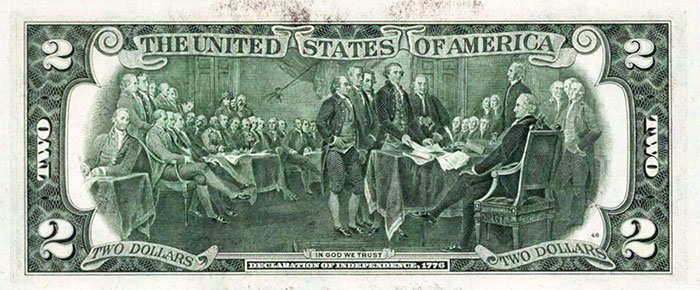
Reintroduced as The Federal Reserve Note
And now begins arguably the most crucial part of history for the two-dollar bill. In 1976 the $2 bill was reintroduced as a Federal Reserve Note.
It’s different from any past notes because it was issued as a Treasury Note. Also called the Bicentennial Two, this bill was owned by the United States central bank.
The 2 dollar bill can be separated into two eras: Pre and post-1976.
The Green Seal Federal Reserve Note began printing at all twelve Federal Reserve banks in 1976. The banks were in Boston, New York City, Philadelphia, Cleveland, Richmond, Atlanta, Chicago, St. Louis, Minneapolis, Kansas City, Dallas, and San Francisco.
What began as the moment collectors thought the $2 bill could be something special was the day that they were printed.

When the bills were printed on April 13, 1976, collectors took them to their local post offices and had the date stamped on them.
Bills with a post office stamp on the first day of issue are highly regarded by coin, stamp, and paper money collectors.
What were the design differences?
Thomas Jefferson remained on the bill but with green serial numbers instead of blue or red. The treasury seal also matched in green.
But on the other side, we no longer saw Thomas Jefferson’s home but instead an engraving by John Trumbull from his famous painting of the signing of the Declaration of Independence.
The Federal Reserve Bank note had a new look. Signature of the Secretary of the Treasury remained.
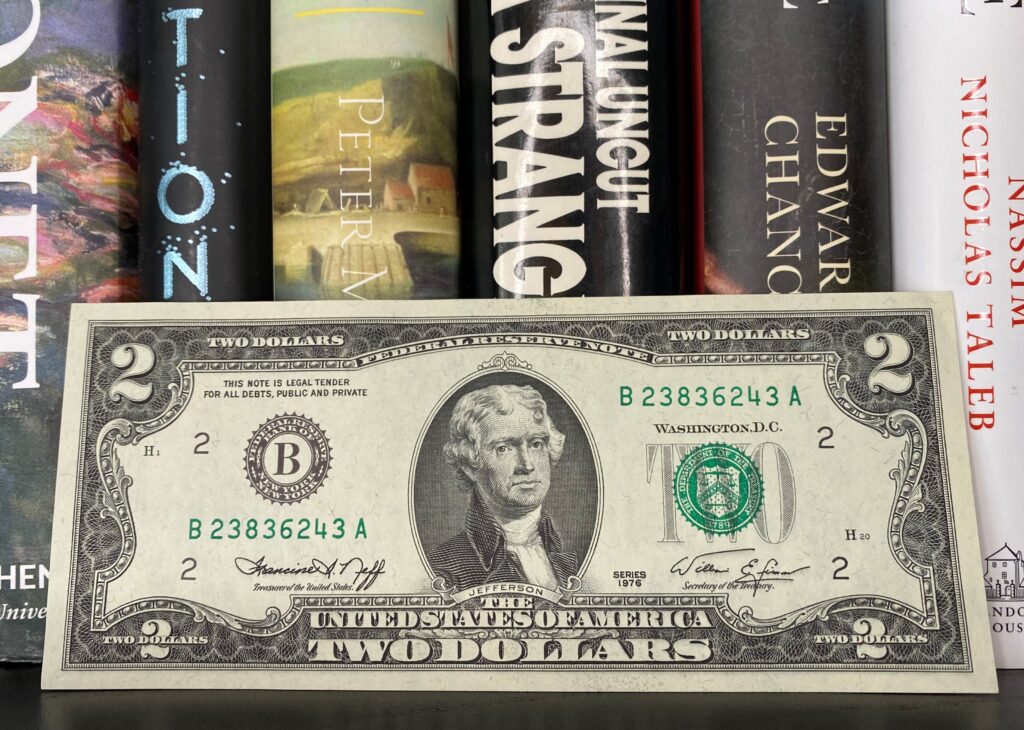
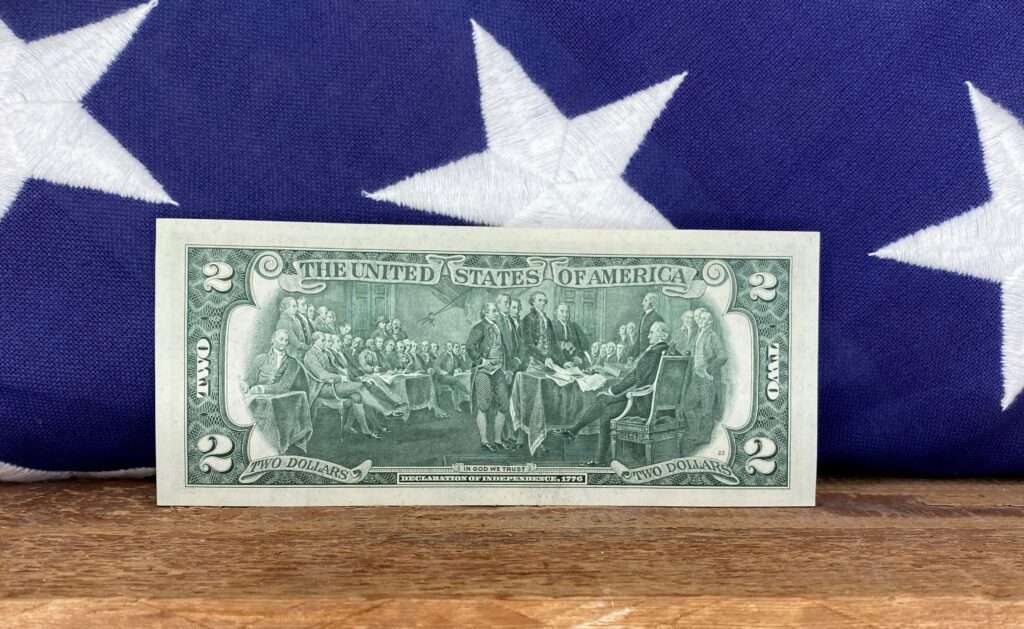
What Does This Mean for Today’s Banknote Values?
An important fact to remember is the $2 bill is not a rare bill. Some say more than 1.4 billion $2 bills were printed. Others say closer to 800 million. Either way, they are plentiful in circulated condition.
If you have a $2 bill that is a regular circulated note, it will be worth face value. What makes things interesting is if you have an uncirculated note.
Most uncirculated bills are worth more, up to $10-$15 on eBay. But some bill collectors are playing the long game and hoping they will be worth thousands someday.
Bills printed from 1862 to 1917 with brown, red, or a blue seal can be valued at hundreds, or even over $1,000 in the collector market on eBay as supply and demand for numismatic collectors rises and falls.
The Fed Still Prints $2 Dollar Paper Currency
A common misconception is that the 2 Dollar Bill is no longer in production, but the Federal Reserve still prints them.
Then how can they be a potential collector’s item? Well, they can be printed at a bank’s request or when it becomes unusable and needs to be destroyed.
It became the rarest current denomination post-1950s because of how infrequently they are printed. Of all currency in circulation, only 1% is $2 bill denominations.
A little-known reason why the $2 bill is kept out of circulation is that many believe it is good luck. They will stick a $2 bill in the wallet and not let it go, preventing circulation.

Whether or not a bill is deemed “destroyed” depends on how it looks. A crumpled, torn, and worn bill will be destroyed and reprinted.
This is up to the Bureau of Engraving and Printing (BEP) and The Federal Reserve to exchange damaged currency for fresh, crisp uncirculated bills.
Dollar coin U.S. currency shelf life? Much more than six years. Interestingly, a one-dollar bill series shelf life is around 18 months, whereas a $2 bill is six years because of the infrequency of use.
So $2 bills are destroyed and reprinted much less frequently.
More recently, The Federal Reserve has amped up production a little more, and now the $2 bill accounts for about 3% of the total printed bills out there.
This furthers the question, are they really a collector’s item?

Collecting $2 Paper Currency
There are a lot of different renditions of the $2 bill, which can create a lot of disparity and confusion on what they are worth.
According to some, the 1917 legal tender note with the red seal stamp can go for $40. This was one of the largest bills before they were standardized.
For all the 1976 bills brought to local post offices for stamps, these can be worth two to four-ish times face value.
This may be disappointing for some. But collectors believe the bills with interesting stamps may be worth more in the future, given their rarity.

Any version of the bills produced from 1928 to the 1950s may be worth more, depending on appraisal. These have value depending on who you sell them to, anywhere from $10 to $30, if in MS 63 grade condition.
Generally, we can look at a few factors to determine value.
- Age – the older it is, the more likely it is worth something.
- Uncirculated bills in fine condition are worth more.
- A low serial number and colors that differentiate a bill make it more unique and valuable.
- A rare star notation near the serial number was printed at the Federal Reserve District Bank of Minneapolis.
- Misprints of seals dollar error notes make the bill rare and valuable.
1976 2 Dollar Star Notes
$2 star notes are designated when damage occurs during printing. A star is placed next to the serial number, marking the misprinted dollar note.
Federal Reserve Notes (FRN) with a star are a much more rare variety than regular printed 2 dollar bills and can be worth $50 to $2,000, depending on if the bill is in good condition.

1976 2 Dollar Error Bills
The 1976 two dollar series includes one important error. It isn’t easy to find unless you’re really paying attention.
There’s a serial number on the front of the bill shown in two separate places, the bottom left and the top right.
Usually, all bills have matching serial numbers, but error bills show two different serial numbers.
A mismatched serial number on the 1976 2 dollar bill has sold at auction for over $500.
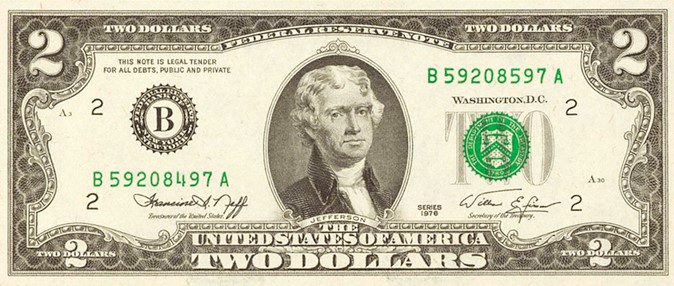
1976 Two Dollar Error Bill Values
1976 Two Dollar Bill Serial Number error bills in very fine condition are valued at roughly $500.
1976 Two Dollar Bill Serial Number error bills in uncirculated condition are valued at roughly $900.
So if you come across a $2 bill, it is worth looking at what decade it’s from and any unique individual features. It may be worth holding for some time, as older versions still need to be reprinted as opposed to the latest bills.
2 dollar bills with low serial numbers can also be extremely valuable in excellent condition, so always glance at the numbers on the bill.

Are $2 Bills Illegal?
No, they are legal United States tender, but in 1966, the $5 and $2 U.S. note denominations were officially discontinued.
Do They Still Print $2 Bills?
Some may assume the U.S. stopped printing $2 bills, but it’s still being made, and there are no plans to stop the $2 bill printing presses.
Made with three-fourths cotton and one-fourth linen content, the “two” will be rolling off the printing presses or the foreseeable future.
Are $2 Bills Hard to Get?
Most banks stock $2 bills, although you may have to specifically request them. Otherwise, you may find 2 dollar bills at retail stores, although it’s more likely they are kept in wallets for good luck rather than in a cash register at the mall.
Is There a $3 Bill?
There’s never been a $3 bill produced by the United States, although, in the 1800s, a gold three-dollar coin was minted for a short time.
Do 4 Dollar Bills Exist?
No, $4 bills have never been printed by the United States Federal Reserve or the United States Treasury. The seven most common denominations are $1, $2, $5, $10, $20, $50, and $100 bills.

Fun Facts –
- The 1976 two-dollar bill became a Federal Reserve Note as opposed to a U.S. Treasury Department Note. Treasury Secretary William E. Simon announced the re-issuance of the “two” with a slight re-design.
- The very first $2 dollar bill was printed in 1862, only one year after the first paper currency began rolling off the U.S. Treasury Department’s printing presses.
- The 1976 two-dollar note is also referred to as the ‘Bicentennial Two’ because the date of issuance fell on the 200th anniversary of the United States as an independent republic.
Continue On Your Rare Currency and Coin Hunting Journey –
- I want to sell my paper currency and coins online, help!
- What is the value of my coins and paper currency?
- Learn the basics of U.S. coinage, start here!


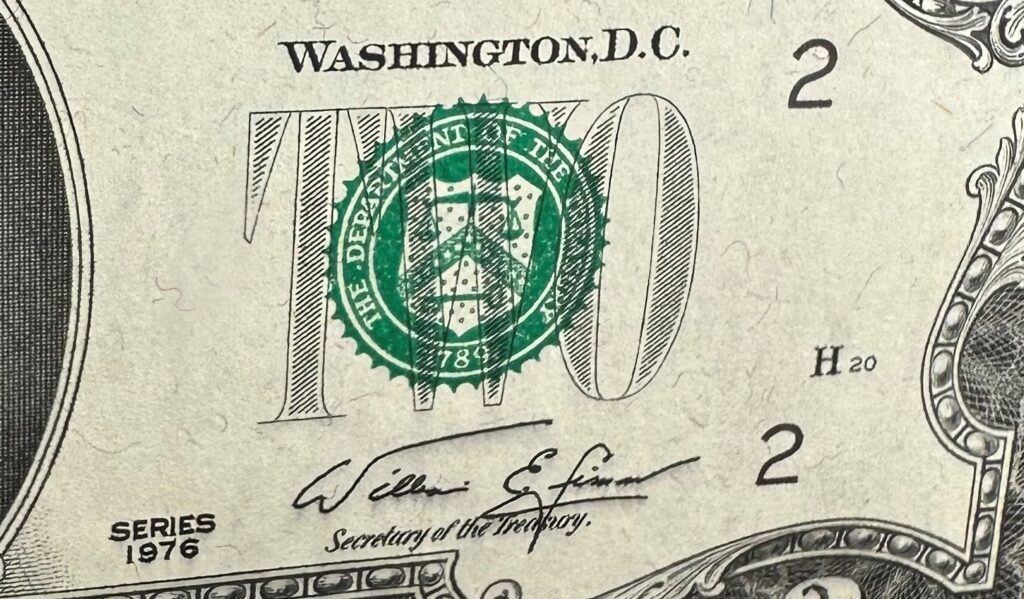

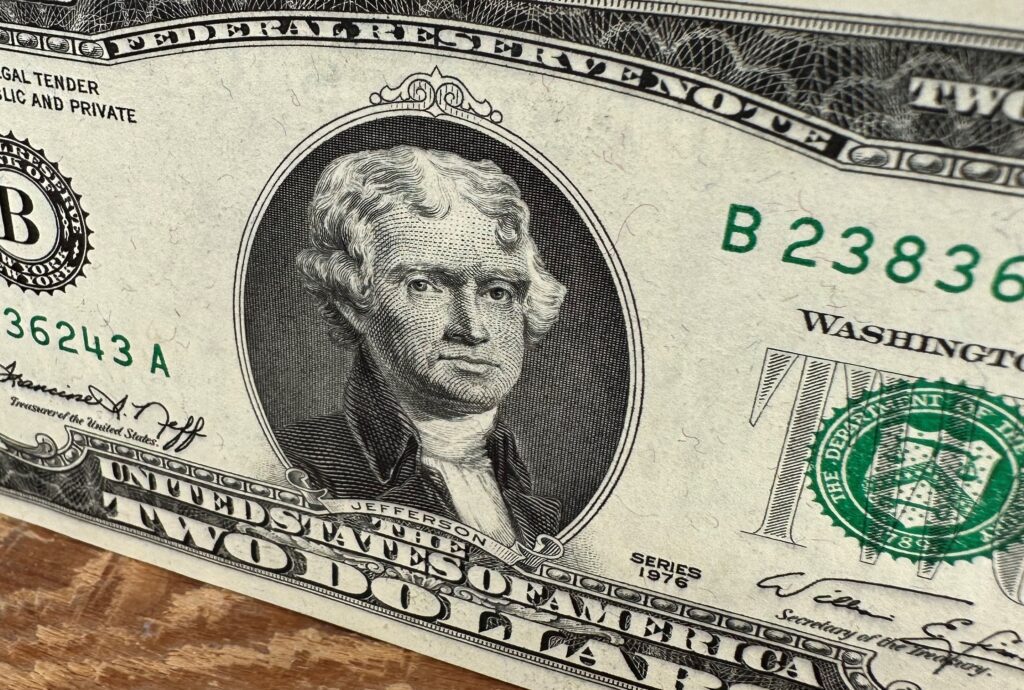


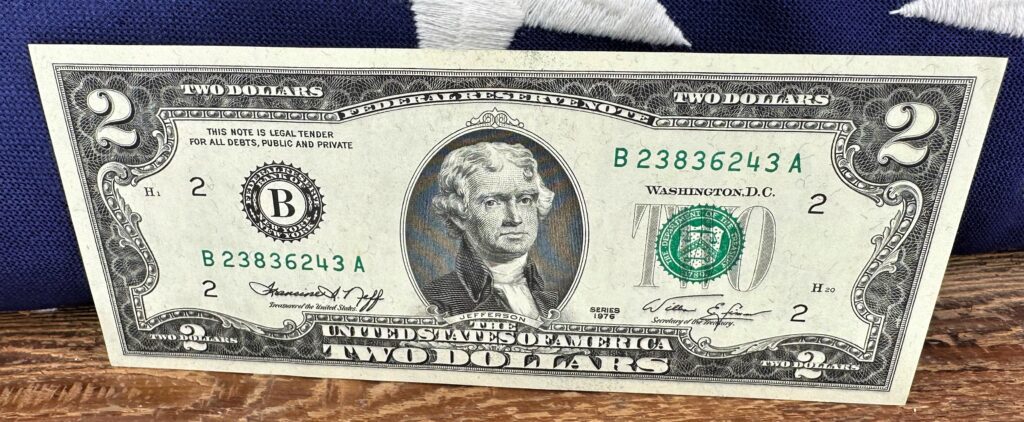


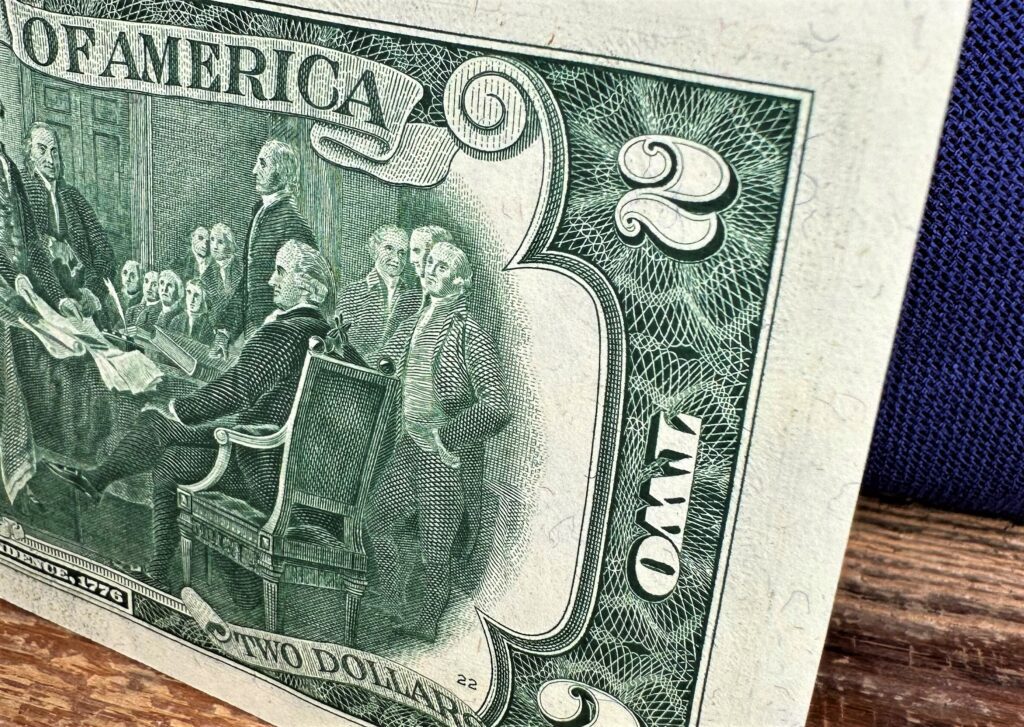
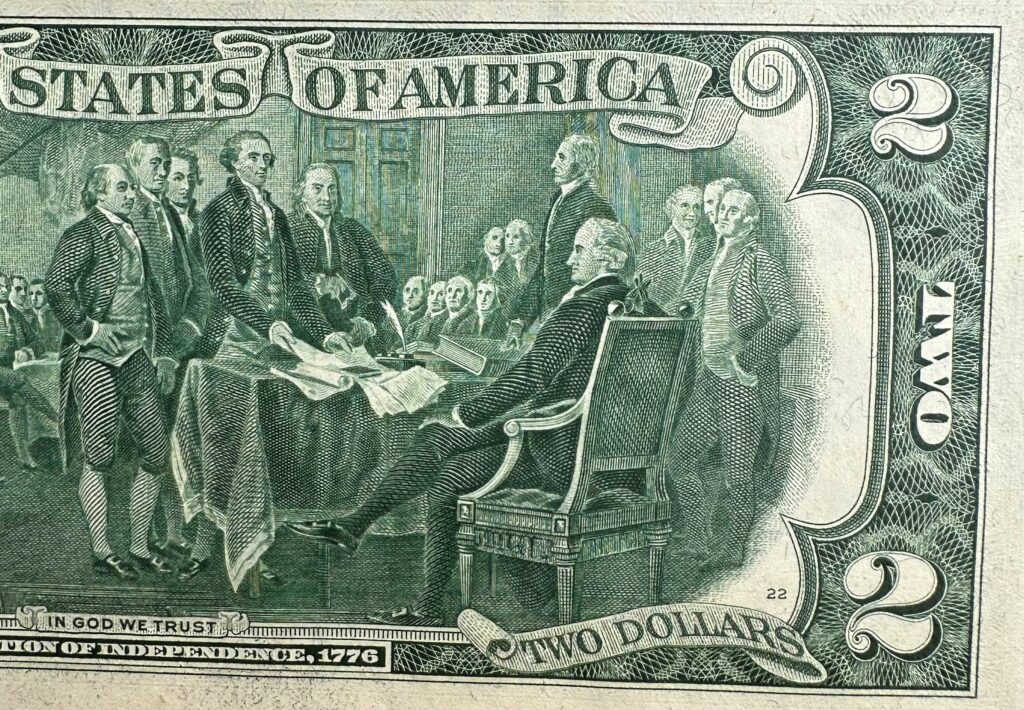



References –
Heritage Auctions – Federal Reserve Star Notes

Tell Us What You Think –
What are your favorite collector coins and paper currency?

I have one that has the serial number G76614138 A and it was printed in 1976 with the Declaration of Independence artwork on the back. Is that of any value?